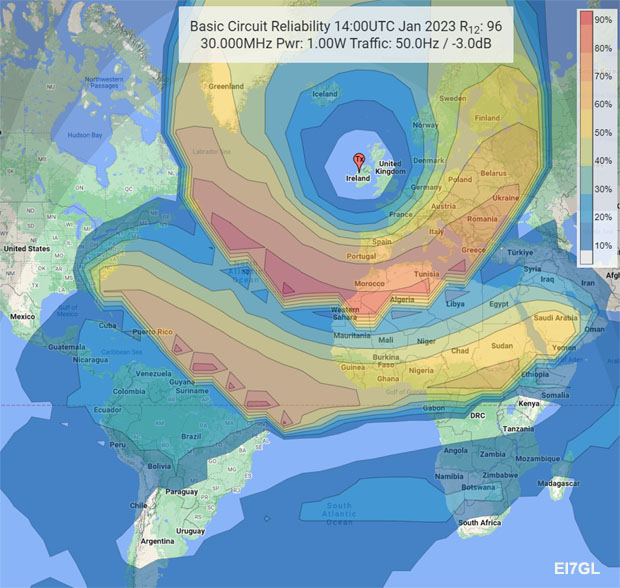On Saturday the 21st and Sunday the 22nd of January 2023, Phil EI9KP conducted some propagation tests on the 9m band in the low-VHF part of the spectrum. He operated a supervised beacon on 34.013 MHz for most of the daylight hours running 1-watt into a horizontal dipole with capacitive loading.
This is a report on who heard his signal over the two days.
Phil, EI9KP writes... "This 34MHz beacon experiment got people interested in listening and I am pleased to have received the reception reports below. Also I'd like to express my thanks to Paul Logan in Co Fermanagh for twittering his followers.
Two reception reports from EI, two from Europe and to my delight a few from the USA.
YO9FTR in Romania at 2795km received the signals on both days. He suggested that start earlier on Day 2, in fact propagation was waiting when I switched on and he decoded the first 15 seconds of the beacon's FT8 sequence.
N2OTO in Florida is near enough twice the distance than VO1FOG in Newfoundland, on the same great circle line.
K5YT at 6864km / 4265 miles was the greatest distance. Edward, K5YT in Texas was using a Hygain TH2-MK3 tribander @ 30m (100’) as a receive antenna.
 |
| FT8 signal received by K5YT in Texas |
The USA reports suggest F2 propagation, but how many hops to FL or TX? What about the one from CT?
YO9FTR made a long observation of the signal/SNR. This wasn't pre-arranged, however, I am thankful for the data and realised there was some pattern in it. The resulting graph shows signal/SNR over several hours, really a nice observation of propagation.
So, I enjoyed the experiment, there's always something new to learn.
73, Phil EI9KP"
~~
The map at the top of the post shows the stations in the USA that heard EI9KP on the 9m band. The map below shows the stations in Europe.
EI9KP's report... Information about reception reports collated from email, 8m Groups.io, VHFSKIP groups.io, Ei7GL blog.
21.01.2023
Beacon 34.013MHz 1W Dipole active from 10:05 till 17:15 UTC
Reception reports:
YO9FTR in the east of Romania, locator KN35XG, from 10:51 till 10:57 UTC, SNR -15 to +14 dB
N2OTO in locator EL96WI, Florida, from 13:12 till 13:19 UTC, SNR -16 to -13 dB
W1IG in locator FN31LN, Connecticut in the USA at 16:08 UTC
N4EF in locator EL98HP, Florida in the USA at 16:10 UTC using an ICOM IC-7610 with a dipole in the attic.
HB9TMC in Switzerland in locator JN46LJ, from 16:53 till 17:01 UTC
EI3GYB in locator IO53OT, over several hours during the afternoon
Spots from PSK Reporter...
21st Jan
Txmtr Rcvr Band Mode Distance Time (UTC)
EI9KP N4EF 9m FT8 6350 km 16:10:14
EI9KP W1IG 9m FT8 4805 km 16:08:14
EI9KP HB9TMC 9m FT8 1526 km 16:53:26
EI9KP N2OTO 9m FT8 6457 km 13:12:15
22.01.2023
Beacon 34.013MHz 1W Dipole active from 08:43 till 17:15 UTC
Reception reports:
YO9FTR in the east of Romania, locator KN35XG, from 08:43 till 11:42 UTC, SNR -21 to +14 dB
K5YT in locator EM22NV, Texas, from 15:03 till 15:11 UTC, SNR from -18 to -7 dB.
N4EF in locator EL98HP, Florida in the USA using an ICOM IC-7610 with a dipole in the attic. FT8 reports from 14:48 to 15:13 UTC and also reports hearing the CW a few times at strength 329.
EI5IN in locator IO63HM, at 15:01 UTC, SNR -21 dB
Spots from PSK Reporter...
22nd Jan
Txmtr Rcvr Band Mode Distance Time (UTC)
EI9KP EI5IN 9m FT8 120 km 15:04:29
EI9KP K5YT 9m FT8 6855 km 15:49:14
If I missed any reports then let me know.
Analysis... It should be noted that the reports above are from a beacon running just 1-watt which is pretty amazing. It just goes to show how far a signal can travel via F2 layer propagation with relatively low attenuation.
Let's have a look at a propagation map.
The map above shows the predicted coverage for a 1-watt operating at 30 MHz. It's not quite 34 MHz but it's close. The solar flux was just around 200-210 for the test.
YO9FTR... For most of the daylight hours, Romania is in the ideal spot for F2 layer propagation and reception of the beacon. The reception chart from YO9FTR further up this post shows reception of the 34 MHz signal from 08:43 to 11:41 UTC.
In the 'old days' when listening just by ear, it would have appeared that the signal was in and out, missing for long periods and then strong for a while. With a weak signal mode like FT8, we can see that the signal was actually there all of the time for three hours. The software was able to decode the FT8 signal when it was buried in the noise.
HB9TMC... It's hard to know for sure what propagation mode was responsible for the reception of the beacon signal in Switzerland. It's seems a bit too close for F2 layer. Was it Sporadic-E? Backscatter? Paul, MI3LDO heard French roads control traffic on 35/36 MHz on Saturday afternoon and thinks it was almost certainly Sporadic-E.
USA... Florida seems to be in the perfect spot for reception. It's the most southerly path and it's in the right area for the second F2 hop. Texas would seem to be at the edge of the footprint.
Overall an interesting test and a very successful one considering the relatively small number of people that would have known about the transmissions. It's also worth noting that very few people have antennas for 34 MHz and most are listening on antennas tuned for other bands.
Ireland is the only country in the world as far as I know where radio amateurs can transmit at 34 MHz (9m band). It lies pretty much half way between the 10m band (28 MHz) and the experimental 8m band at 40 MHz.
For more information about other 34 MHz tests, I'll keep the posts on my 40 MHz page HERE




























